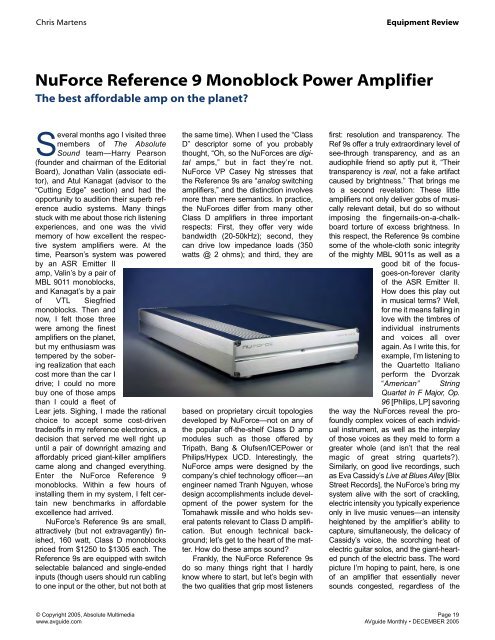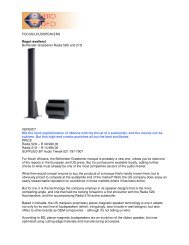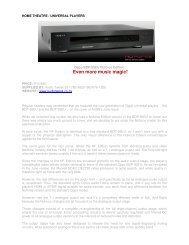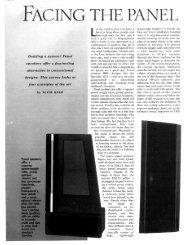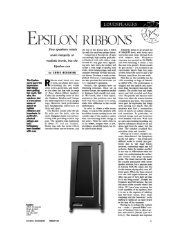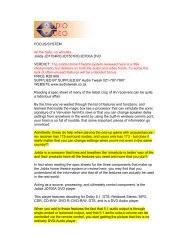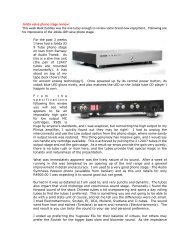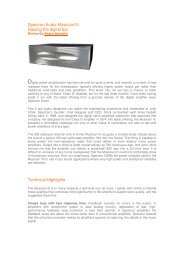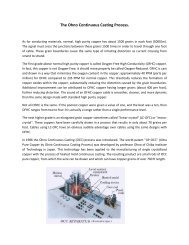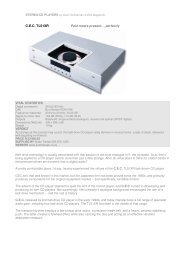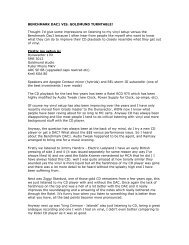V1Review by Absolute Sound - Audio Tweak
V1Review by Absolute Sound - Audio Tweak
V1Review by Absolute Sound - Audio Tweak
You also want an ePaper? Increase the reach of your titles
YUMPU automatically turns print PDFs into web optimized ePapers that Google loves.
Chris Martens<br />
Equipment Review<br />
NuForce Reference 9 Monoblock Power Amplifier<br />
The best affordable amp on the planet?<br />
Several months ago I visited three<br />
members of The <strong>Absolute</strong><br />
<strong>Sound</strong> team—Harry Pearson<br />
(founder and chairman of the Editorial<br />
Board), Jonathan Valin (associate editor),<br />
and Atul Kanagat (advisor to the<br />
“Cutting Edge” section) and had the<br />
opportunity to audition their superb reference<br />
audio systems. Many things<br />
stuck with me about those rich listening<br />
experiences, and one was the vivid<br />
memory of how excellent the respective<br />
system amplifiers were. At the<br />
time, Pearson’s system was powered<br />
<strong>by</strong> an ASR Emitter II<br />
amp, Valin’s <strong>by</strong> a pair of<br />
MBL 9011 monoblocks,<br />
and Kanagat’s <strong>by</strong> a pair<br />
of VTL Siegfried<br />
monoblocks. Then and<br />
now, I felt those three<br />
were among the finest<br />
amplifiers on the planet,<br />
but my enthusiasm was<br />
tempered <strong>by</strong> the sobering<br />
realization that each<br />
cost more than the car I<br />
drive; I could no more<br />
buy one of those amps<br />
than I could a fleet of<br />
Lear jets. Sighing, I made the rational<br />
choice to accept some cost-driven<br />
tradeoffs in my reference electronics, a<br />
decision that served me well right up<br />
until a pair of downright amazing and<br />
affordably priced giant-killer amplifiers<br />
came along and changed everything.<br />
Enter the NuForce Reference 9<br />
monoblocks. Within a few hours of<br />
installing them in my system, I felt certain<br />
new benchmarks in affordable<br />
excellence had arrived.<br />
NuForce’s Reference 9s are small,<br />
attractively (but not extravagantly) finished,<br />
160 watt, Class D monoblocks<br />
priced from $1250 to $1305 each. The<br />
Reference 9s are equipped with switch<br />
selectable balanced and single-ended<br />
inputs (though users should run cabling<br />
to one input or the other, but not both at<br />
the same time). When I used the “Class<br />
D” descriptor some of you probably<br />
thought, “Oh, so the NuForces are digital<br />
amps,” but in fact they’re not.<br />
NuForce VP Casey Ng stresses that<br />
the Reference 9s are “analog switching<br />
amplifiers,” and the distinction involves<br />
more than mere semantics. In practice,<br />
the NuForces differ from many other<br />
Class D amplifiers in three important<br />
respects: First, they offer very wide<br />
bandwidth (20-50kHz); second, they<br />
can drive low impedance loads (350<br />
watts @ 2 ohms); and third, they are<br />
based on proprietary circuit topologies<br />
developed <strong>by</strong> NuForce—not on any of<br />
the popular off-the-shelf Class D amp<br />
modules such as those offered <strong>by</strong><br />
Tripath, Bang & Olufsen/ICEPower or<br />
Philips/Hypex UCD. Interestingly, the<br />
NuForce amps were designed <strong>by</strong> the<br />
company’s chief technology officer—an<br />
engineer named Tranh Nguyen, whose<br />
design accomplishments include development<br />
of the power system for the<br />
Tomahawk missile and who holds several<br />
patents relevant to Class D amplification.<br />
But enough technical background;<br />
let’s get to the heart of the matter.<br />
How do these amps sound?<br />
Frankly, the NuForce Reference 9s<br />
do so many things right that I hardly<br />
know where to start, but let’s begin with<br />
the two qualities that grip most listeners<br />
first: resolution and transparency. The<br />
Ref 9s offer a truly extraordinary level of<br />
see-through transparency, and as an<br />
audiophile friend so aptly put it, “Their<br />
transparency is real, not a fake artifact<br />
caused <strong>by</strong> brightness.” That brings me<br />
to a second revelation: These little<br />
amplifiers not only deliver gobs of musically<br />
relevant detail, but do so without<br />
imposing the fingernails-on-a-chalkboard<br />
torture of excess brightness. In<br />
this respect, the Reference 9s combine<br />
some of the whole-cloth sonic integrity<br />
of the mighty MBL 9011s as well as a<br />
good bit of the focusgoes-on-forever<br />
clarity<br />
of the ASR Emitter II.<br />
How does this play out<br />
in musical terms? Well,<br />
for me it means falling in<br />
love with the timbres of<br />
individual instruments<br />
and voices all over<br />
again. As I write this, for<br />
example, I’m listening to<br />
the Quartetto Italiano<br />
perform the Dvorzak<br />
“American” String<br />
Quartet in F Major, Op.<br />
96 [Philips, LP] savoring<br />
the way the NuForces reveal the profoundly<br />
complex voices of each individual<br />
instrument, as well as the interplay<br />
of those voices as they meld to form a<br />
greater whole (and isn’t that the real<br />
magic of great string quartets?).<br />
Similarly, on good live recordings, such<br />
as Eva Cassidy’s Live at Blues Alley [Blix<br />
Street Records], the NuForce’s bring my<br />
system alive with the sort of crackling,<br />
electric intensity you typically experience<br />
only in live music venues—an intensity<br />
heightened <strong>by</strong> the amplifier’s ability to<br />
capture, simultaneously, the delicacy of<br />
Cassidy’s voice, the scorching heat of<br />
electric guitar solos, and the giant-hearted<br />
punch of the electric bass. The word<br />
picture I’m hoping to paint, here, is one<br />
of an amplifier that essentially never<br />
sounds congested, regardless of the<br />
© Copyright 2005, <strong>Absolute</strong> Multimedia<br />
www.avguide.com<br />
Page 19<br />
AVguide Monthly • DECEMBER 2005
Chris Martens<br />
Equipment Review<br />
complexity of the material being played<br />
(a quality the the ASR exhibits to an<br />
even greater degree).<br />
Next, as a bassist, I feel compelled to<br />
point out that the NuForces deliver the<br />
best doggone bass-pitch definition and<br />
control I’ve ever heard from any amplifier.<br />
Part of what’s going on is that the<br />
NuForces offer a damping factor<br />
greater than 4000 (no, that’s not a typo),<br />
so that when the Ref 9s tell woofers<br />
what to do, the drivers have little choice<br />
but to shut up and follow orders—precisely.<br />
The sonic results can be eyepopping<br />
in several ways. First, the Ref<br />
9s seem to give some speakers (e.g.,<br />
my Magnepans) about an extra half<br />
octave of bass extension they never had<br />
before. Second, the amps draw out<br />
layer upon layer of bass textures and<br />
detail you may never have heard before.<br />
A few nights back I put on master<br />
acoustic bassist Dave Holland’s<br />
Emerald Tears [ECM, LP] and listened<br />
in shocked amazement as the<br />
NuForces revealed one new subtlety<br />
after another (the intricacy of Holland’s<br />
solo work is just unbelievable!). The only<br />
word of caution I would offer is that the<br />
NuForces handle low frequencies with<br />
the utmost control, and therefore will not<br />
artificially “warm up” either recordings or<br />
loudspeakers that lack bass. But put<br />
these amps together with recordings<br />
and associated gear that can do bass<br />
well and it’s “fasten your seatbelts” time.<br />
The NuForces offer lively and expressive<br />
dynamics, doing an especially good<br />
job with leading edge transients and<br />
moderate to large orchestral swells.<br />
One potential problem, though, is that<br />
the amps are so expressive that you<br />
tend to forget that they produce “only”<br />
160Wpc; when pushed to their limits the<br />
Ref 9s eventually run out of steam<br />
before blockbusters such as Musical<br />
Fidelity’s kW500 would. When driven at<br />
less than “go-nuts” volume levels, however,<br />
the NuForces paradoxically sound<br />
more authoritative and dynamically alive<br />
than many higher-powered amps do.<br />
Finally, I found the Ref 9s produced<br />
very wide and deep soundstages,<br />
though not quite on a par with the MBL<br />
9011s or, especially, the ASR Emitter II<br />
(the ASR is, I think, in a class <strong>by</strong> itself<br />
in terms of soundstage depth and precision).<br />
Nevertheless, the NuForces<br />
can go toe-to-toe with amps several<br />
times their price and prevail <strong>by</strong> virtue<br />
of their uncanny ability to delineate<br />
layers of front-to-back depth in the<br />
soundstage, and to reproduce small<br />
reverberant details that suggest the<br />
acoustics of the recording venue.<br />
What can’t the Reference 9s do? Well,<br />
one thing they don’t do, or at least don’t<br />
do easily, is to present the sort of holographic,<br />
“glowing from within” midrange<br />
qualities that the very finest tube amplifiers<br />
sometimes exhibit (the VTL<br />
Siegfrieds and certain WAVAC amplifiers<br />
would be good examples). Though I<br />
would never call the NuForces sterilesounding,<br />
they do have a certain accurate-to-a-fault,<br />
garbage-in/garbage-out<br />
quality. Basically, these amps will try and<br />
make speakers conform to the incoming<br />
music signals, for better or worse. But in<br />
a sense this very faithfulness to the signal<br />
is what makes the Reference 9 so<br />
rewarding on great recordings.<br />
An open-ended question, and one<br />
that will bear further research, is<br />
whether other modern Class D amplifiers<br />
sound as good as the NuForces<br />
do. Thus far, I’ve briefly heard Class D<br />
amplifiers from Channel Islands <strong>Audio</strong>,<br />
Kharma, and Red Dragon <strong>Audio</strong>, and<br />
felt that each offered a lot of potential<br />
(though each sounded different from<br />
the others). I feel safe asserting that<br />
Class D technology has come of age,<br />
even for demanding audiophiles<br />
Prospective buyers should know that<br />
the NuForce amps have some minor<br />
quirks, which, to NuForce’s great credit,<br />
are mostly covered in the amps’ documentation.<br />
First, the amplifiers require<br />
about 75 hours of burn-in before sounding<br />
their best. Second, the amps must<br />
be connected to loudspeaker loads<br />
before being turned on. Third, the amps<br />
produce an annoying “scrritttch” when<br />
first powered up. Fourth, the NuForces<br />
sometimes exhibit a small but audible<br />
increase in background noise when<br />
preamp outputs are temporarily muted,<br />
though when preamp outputs are not<br />
muted the NuForces become dead<br />
quiet. Finally, the Ref 9s are very sensitive<br />
to ancillary cabling, input connectors,<br />
binding posts, and the like. For this<br />
reason I strongly recommend ordering<br />
your Reference 9s with the optional<br />
WBT NextGen RCA jacks (these will set<br />
you back an extra 55 bucks per amp,<br />
but they are worth every red cent).<br />
Do you find it hard to swallow the<br />
idea that a $2610 pair of monoblocks<br />
can compete on a nearly equal footing<br />
with amplifiers many times their price?<br />
I certainly did, but after loaning the<br />
NuForces to a colleague whose reference<br />
system is far more exotic than my<br />
own, the verdict stayed the same: The<br />
Reference 9s really are that good.<br />
Therefore, I urge you to run, not walk,<br />
to the nearest NuForce dealer to audition<br />
a set ASAP. If your reactions are<br />
even half as favorable as mine, you’ll<br />
need your checkbook. Go, now.<br />
NuForce Reference 9 monoblock Class D<br />
power amplifier<br />
STRENGTHS<br />
• Superb transparency, resolution, and bass; near<br />
world-class soundstaging; lively, explosive<br />
dynamics; compact size and low weight; incredible<br />
value-for-money.<br />
WEAKNESSES<br />
• Some quirks; only rarely delivers tube-like luminous<br />
midrange; 160 Wpc not enough for some<br />
speakers (can NuForce build a bigger version that<br />
sounds this good?).<br />
SPECIFICATIONS<br />
NuForce Reference 9 monoblock Class<br />
D power amplifier<br />
Price: $1305, as tested. ($1250, basic<br />
amplifier; $55, WBT NextGen RCA jack<br />
option).<br />
Power output: 160 watt @ 8 ohms, 300<br />
watts @ 4 ohms, 350 watts @ 2 ohms<br />
Number and type of audio inputs: one<br />
balanced (XLR), one single-ended<br />
(RCA), switch selectable.<br />
Dimensions: 8.5” x 15” x 1.8”<br />
Weight: 7 lbs.<br />
MANUFACTURER’S INFORMATION<br />
NUFORCE (NPHYSICS)<br />
(408) 426-4165<br />
www.nuforce.com<br />
ASSOCIATED EQUIPMENT<br />
Magnepan MG1.6 and Monitor <strong>Audio</strong><br />
Silver Series RS6loudspeakers, Rogue<br />
<strong>Audio</strong> Metis and Usher P-307 preamplifiers,<br />
Musical Fidelity Tri-Vista 300 and<br />
kW500 integrated amplifiers, Musical<br />
Fidelity Tri-Vista SACD player, Kuzma<br />
Stabi S/Stogi S and Linn Sondek LP-<br />
12/Ittok LVII turntables and tonearms,<br />
Benz Micro ACE “L” and Shelter 90X<br />
phono cartridges, Supex SDT-722 stepup<br />
transformer, Musical Surroundings<br />
Phonomena phonostage, Cardas<br />
Neutral Reference and PNF <strong>Audio</strong><br />
Icon/Symphony interconnects/speaker<br />
cables, RCPG 1200S power conditioner.<br />
© Copyright 2005, <strong>Absolute</strong> Multimedia<br />
www.avguide.com<br />
Page 20<br />
AVguide Monthly • DECEMBER 2005


